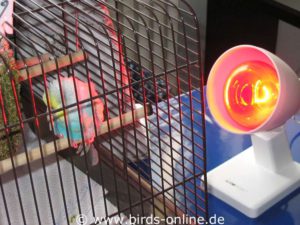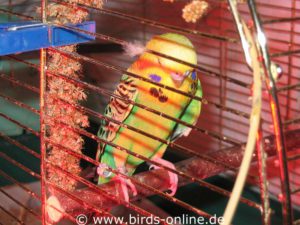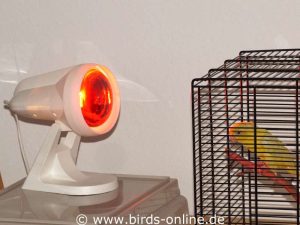- >>
- Birds Online – English
- >>
- Health and diseases
- >>
- General health topics
- >>
- What you can do...
- >>
- Keeping your bird warm
Keeping your bird warm

If a bird is sick, in most cases it needs not only effective medication but often also warmth. The reason for this is that many sick birds freeze because their body temperature does not correspond to the usual level: The regular body temperature of a budgie is approximately 105 degrees Fahrenheit (40 degrees Celsius). If the organism fights a disease, it has less energy available for internal heating – the body temperature drops. It’s the same in case of severe injuries and shock conditions.
For a sick or injured bird, this means that she or he is cold in addition to her or his discomfort caused by the disease or injury itself. A bird who feels cold also does not recover as quickly as an animal that does not freeze. Therefore it is important to support sick birds by offering them additional warmth while they’re recovering. It is best to place them in a warm, draught-free room and also expose them to infrared light. To do so, you can use a medical infrared lamp or other special lamps. However, there are a few details to consider.
Most medical heat lamps are quite bright. They can strongly dazzle a bird if she or he has to look into the light for a while. However, severely ill birds usually keep their eyes closed most of the time anyway. In this respect, the risk of eye damage caused by the temporary use of such heating lamps is quite low. Nevertheless, there are reports of cases in which birds have gone blind due to the use of infrared light. If you do not want to take any risks, you should seek advice from your avian vet. There are special infrared lamps for animals that are not bright, but warm. Such lamps can generally be used without problems.
It depends on the individual case, which lamp is the best. For this reason, an experienced dealer should be consulted to clarify the respective requirements for the lamp and to determine the appropriate wattage. For example, the distance to the bird in which the lamp can be placed in your home is an important aspect. Due to this fact, I do not give a general recommendation at this point, because this would be unreliable.

Place the lamp at the appropriate distance in front of the cage of your sick bird. Please make sure that it does not get too hot for the animal inside the whole cage. Your feathered patient should be able to retreat to a cooler place in the domicile. You can simply hang a cloth in front of one half of the cage so that the bird can sit behind it if desired.
However, under no circumstances you should wrap the cloth around one half of the cage because the heat could accumulate in this area. If your bird perches there, it could be too hot for your little patient. The cloth should only be attached in front of one half of the cage, for example on the cage roof using clothespins. To the rear, the cage should not be covered, so the air can circulate more easily and the feathered patient is not threatened with overheating.

Depending on the illness of your bird, it is also often useful to have the animal inhale additionally. You should discuss this with your avian vet. In general, when warming your bird with a heat lamp, the air humidity should not be too low, which is often a problem, especially during winter when the heater is on. If budgies are kept indoors, the humidity should be approximately 60 to 70 percent. In this manner, you can ensure that the sensitive respiratory organs of the birds do not dry out. By the way, for other bird species, different recommendations apply regarding humidity.
Whether and how long you should warm your sick bird with an infrared lamp depends on the illness or injury. You should always consult your avian vet (at least by phone) before starting the treatment. Your bird doctor will be happy to give you information and, if necessary, further advice.
